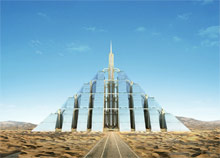A proposed pyramid city for the Dubai desert will stand about 4000 feet in height, dwarfing the Burj Dubai – the tallest tower in the world – by hundreds of metres.
The solar-powered pyramid project – dubbed Ziggurat after the ancient Mayan pyramids – was announced this week by Timelinks, an eco-design firm that plans to unveil the engineering wonder at Cityscape Dubai later this year.
If completed, it’s expected to be the largest man-made residential structure on the planet, with its foundation covering more than two square kilometres.
"The pyramid will be more than a kilometre tall and will house one million people inside," "It will be completely self-sustainable."
Using solar and wind power, the mega structure will create its internal weather. Steam generated from solar power and collected through photovoltaic cell panels on the pyramid’s exterior might well be piped from the ground level to the uppermost heights of the pyramid’s interior and then released, instantly turning into rain, which may then fall on the lush garden communities inside the pyramid.
An eco system, full of vegetation, mild temperatures and regular rainfall, may make this a highly marketable city for people living in dry desert conditions.
In a statement, Ridas Matonis, Timelinks Managing Director, said: "Communities [Ziggurat] can be almost totally self-sufficient energy-wise. Apart from using steam power in the building, we will also employ wind turbine technology to harness natural energy resources."
Matonis said the pyramid project requires 90 per cent less land than a traditional city. "Cities can be accommodated in complexes that take up less than 10 per cent of the original land surface. Public and private landscaping will be used for leisure pursuits or irrigated as agricultural land."
"Timelinks has patented the design and technology incorporated into the project and has applied to the European Union for a grant for technical projects," the firm said. "A number of eminent professors will be on hand to explain the technicalities of how the Ziggurat project works and how these communities can be integrated in master projects."

